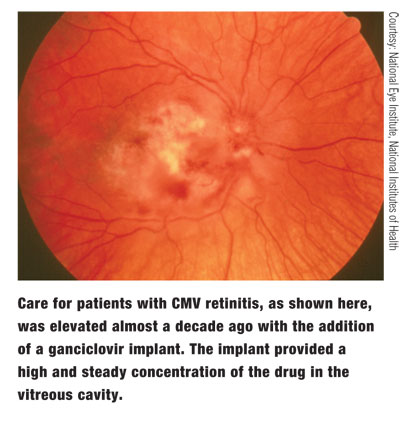
Almost a decade ago, the treatment for cytomegalovirus (CMV) was elevated by the addition of a sustained-release ganciclovir implant to treat CMV retinitis. This was considered advantageous, because intravenous administration of drugs was costly, time consuming and complicated by toxicities.1
Sustained-release ganciclovir devices quickly became the mainstay for treating CMV. Not only did they offer better effect at the site of the inflammation and better control; there was also considerably less progression and less bone marrow and renal toxicity compared with the systemic therapy previously utilized.2 Also, the ganciclovir implant provided a high and steady concentration of the drug in the vitreous cavity for more than seven to eight months.3

Because the incidence of CMV has increased in recent years, there has been a greater need for implant technology. Furthermore, ganciclovir implants really set the stage for future drug delivery modalities.
Research into drug delivery systems has remained an exciting development during the last few years and is expected to grow continuously. Time-release technology, ranging from a few hours to 30 months, has allowed patients to eliminate using topical, oral or I.V. drugs for several ocular pathologies.
Retisert
The Retisert (fluocinolone acetonide, Bausch & Lomb) intravitreal implant was approved in 2005 for the treatment of posterior uveitis. The sustained-release implant lasts for 30 months.4
In one three-year study, 278 patients with noninfectious posterior uveitis had the implant inserted through a pars plana incision. A review of the data at 34 weeks looked at efficacy outcomes.5 One area of considerable improvement: the recurrence rate of uveitis. It decreased from 51.4% in the control group (which received systemic, periocular and topical therapies) to 6.1% in the Retisert group. Visual acuity stabilized or improved in 87% of the patients.
This technology also has typical long-term risks of steroids. In the above-mentioned study, 51.1% of treated eyes also required topical glaucoma drops, and 9.9% required cataract surgery.

However, this device has changed the lives of patients with chronic posterior uveitisespecially when you consider the improved visual acuity, long-term control of inflammation and significant decrease in the need for adjunctive anti-inflammatory medications. It received fast track approval because of the results in treating sight-threatening inflammatory disease, which affects more than 175,000 Americans and includes diseases ranging from juvenile rheumatoid arthritis to Behets disease.
In the future, Bausch & Lomb will likely seek indications for treating diabetic macular edema and age-related macular degeneration with Retisert. 6

Where to Next?
Given the benefits of delivering medications directly to the site of disease, we can expect that similar drug-delivery technologies will continue to be researched and come to market.
Other systems in the near future include the Posurdex (dexamethasone, Oculex/Allergan), a biodegradable sustained-release implant that delivers dexamethasone directly to the targeted disease site at the back of the eye. The drug is aimed at treating macular edema.
Eventually, micro-needle and nanotechnology will impact eye care as research continues to develop. In fact, the NEI offered a $7 million grant to support transscleral drug delivery devices, which involve hundreds of micro-needles and nanoparticles for treating choroidal and outer retinal disease.7
Indeed, research is advancing the treatment of these serious, sight- threatening conditions, and patients are reaping the benefits.
Dr. Karpecki is a consultant to Bausch & Lomb and Allergan, but has no financial interest in any products mentioned here.
1. Bright DC. Pharmacologic management of cytomegalovirus retinitis: review of current and future therapeutic modalities. J Am Optom Assoc 1997 Jan;68(1):11-30. Review.
2. Anand R. Treatment of cytomegalovirus retinitis with the intraocular ganciclovir implant. Curr Opin Ophthalmol 1997 Jun;8(3):8-14.
3. Chang M, Dunn JP. Ganciclovir implant in the treatment of cytomegalovirus retinitis. Expert Rev Med Devices 2005 Jul;2(4):421-7.
4. Lim LL, Smith JR, Rosenbaum JT. Retisert (Bausch & Lomb/ Control Delivery Systems). Curr Opin Investig Drugs 2005 Nov;6(11):1159-67.
5. Jaffe GJ, Martin D, Callanan D, et al. Fluocinolone acetonide implant (Retisert) for noninfectious posterior uveitis : thirty-four week results of a multicenter randomized clinical study. Ophthalmology 2006 Jun;113(6):1020-7.
6. Fluocinolone acetonide ophthalmicBausch & Lomb: fluocinolone acetonide Envision TD implant. Drugs RD 2005;6(2): 116-9.
7. Bourges JL, Bloquel C, Thomas A, et al. Intraocular implants for extended drug delivery: therapeutic applications. Adv Drug Deliv Rev 2006 Nov 15;58(11):1182-202.

